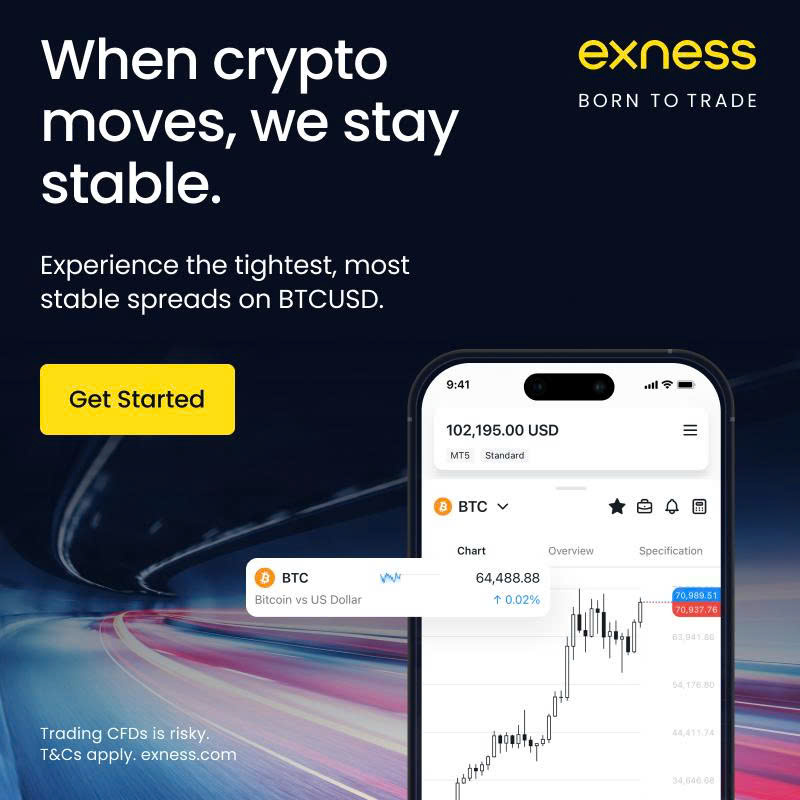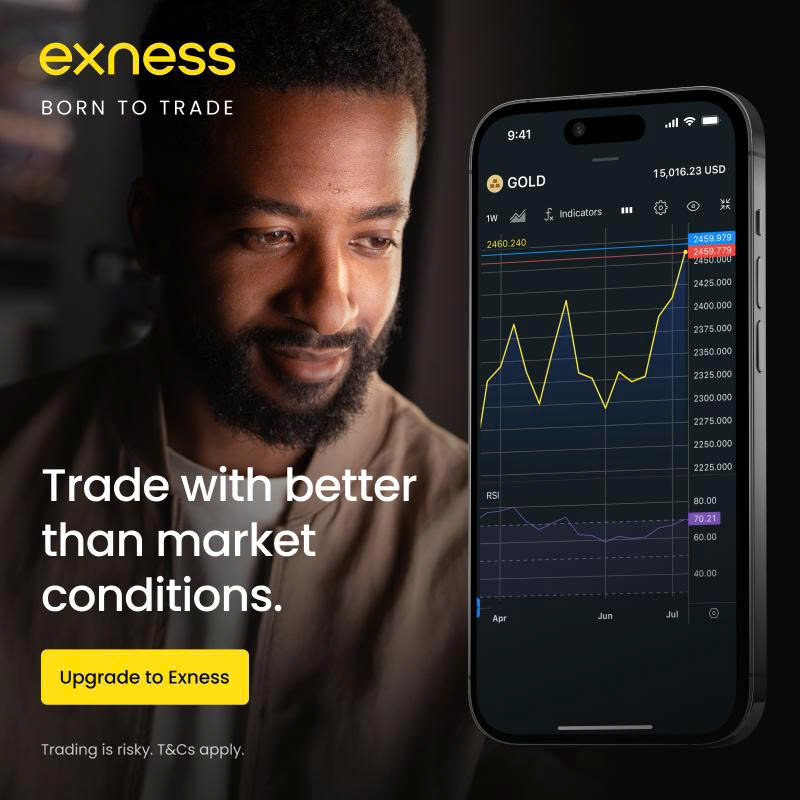
6 minute read
Best Leverage for Beginners on Exness: What You Need to Know
from Exness
by Exness Blog
If you're a beginner looking to trade on Exness, the best leverage to start with is 1:100 or lower. This range gives you the ability to control a larger position size than your account balance would normally allow—while keeping your risk at a manageable level. Starting with high leverage like 1:1000 or 1:2000 might sound attractive, but it’s one of the fastest ways for a beginner to blow an account.

✅ Trade with Exness now: Open An Account or Visit Brokers 👈
Let’s break this down step-by-step so you understand why 1:100 is the sweet spot for beginners and how Exness leverage actually works.
What is Leverage in Forex Trading?
Leverage in forex is a tool that allows you to control a large position with a relatively small amount of capital. For example, if you have $100 and use 1:100 leverage, you can control a trade size of $10,000. It sounds like a great opportunity—and it is—but it can also be a dangerous weapon if misused.
Higher leverage increases both your potential profits and potential losses. That’s why understanding leverage is absolutely crucial for new traders on platforms like Exness.
How Does Leverage Work on Exness?
Exness offers flexible leverage, and in some account types, even unlimited leverage. This is a major draw for experienced traders who know how to manage risk. But for beginners, the best practice is to set limits manually in your account settings.
On Exness, you can choose from various leverage levels depending on your account type, the amount of equity you have, and the trading instrument. For example:
· Major forex pairs allow higher leverage.
· Minor and exotic pairs, cryptocurrencies, and commodities usually have lower maximum leverage.
· Equity size affects leverage: The more money in your account, the lower your maximum available leverage becomes for safety reasons.
If you start with less than $1000, Exness might offer leverage up to 1:Unlimited—but that doesn’t mean you should use it.
Why 1:100 is the Best Leverage for Beginners
Let’s be honest: most beginners lose their first trading accounts not because they choose the wrong broker, but because they choose excessive leverage and overtrade.
Starting with 1:100 leverage gives you enough trading power to participate meaningfully in the market, while still preserving the educational experience of learning how price moves. You won't get wiped out by a minor fluctuation, and you’ll learn how to manage risk, use stop-losses, and understand position sizing.
Here’s why 1:100 is ideal:
1. Balance between risk and reward: You get access to decent position sizes, but your losses won’t escalate as quickly as with higher leverage.
2. Better control over emotions: With lower risk exposure, you won’t panic easily, and emotional decisions (which destroy many accounts) are less likely.
3. More room for error: As a beginner, you're bound to make mistakes. 1:100 gives you more margin for learning without blowing up your account in one or two bad trades.
4. Improves risk management discipline: With 1:100, you are encouraged to learn how to calculate lot sizes and understand margin requirements.
What Happens if You Use Too Much Leverage?
Let’s say you deposit $50 and use 1:2000 leverage on Exness. That allows you to open a position size of $100,000. Sounds amazing, right? But even a 10-pip movement against your trade could wipe out your entire $50. There’s no room to adjust, learn, or adapt.
High leverage magnifies both profits and losses. And since beginners lose more often than they win, high leverage is not a weapon—it’s a landmine.
Some common mistakes beginners make with high leverage:
· Opening too many positions: Because the margin requirement is small, they open multiple trades and overexpose themselves.
· No stop-loss: Thinking the market will "turn around," many beginners don’t use stop-loss orders and end up in deep losses.
· Emotional trading: High leverage can turn a rational trader into a gambler. The highs are high, and the lows are devastating.

✅ Trade with Exness now: Open An Account or Visit Brokers 👈
How to Change Leverage on Exness
On Exness, adjusting leverage is easy:
1. Log in to your Exness Personal Area.
2. Click on your trading account.
3. Click “Change leverage.”
4. Choose your preferred leverage (1:1 to 1:Unlimited depending on account type).
5. Save your changes.
It’s important to note that changes to leverage only apply to new trades. Existing trades retain the leverage that was in place when they were opened.
As a beginner, it’s best to set your leverage and stick with it until you develop more experience and confidence in managing risk.
Best Practices for Leverage Management on Exness
Leverage is just a tool. Used well, it can be your best ally. Used recklessly, it can ruin your account overnight.
Here’s what beginners should do:
· Use leverage conservatively: 1:50 or 1:100 is more than enough for small accounts.
· Always use a stop-loss: This limits your loss if the market goes against you.
· Understand margin requirements: Know how much money is required to open and maintain your positions.
· Avoid trading during high volatility events: News releases and economic events can cause price spikes that wipe out leveraged accounts.
· Keep learning: The more you understand technical and fundamental analysis, the better you can manage trades and leverage wisely.
Should You Ever Use 1:2000 or 1:Unlimited Leverage?
Unless you are running a tested trading strategy with proper risk management, absolutely not.
These ultra-high leverage options exist for professional traders who can control their emotions, calculate precise risk, and have proven success rates. As a beginner, even if you’re tempted to try 1:2000 leverage to grow your $50 into $500, you’re more likely to turn it into $0 within minutes.
The exception might be if you are running micro-lots and using tight stop-losses, but even then, it’s unnecessary. The gain in flexibility isn’t worth the increased risk when you’re still learning how markets work.
How Leverage Affects Margin and Stop-Out Levels
Exness has a margin call and stop-out system that’s directly affected by your leverage level.
· Margin Call: This is a warning that your equity has dropped below a certain percentage of your used margin.
· Stop-Out Level: This is when Exness will automatically start closing your positions to prevent your account from going negative.
Lower leverage means you need more margin to open a trade, but it also provides better cushioning against stop-outs.
Beginners often misunderstand this relationship and end up overleveraging. Stick to 1:100, and you’ll have a much more stable experience.
Final Thoughts: Leverage is Not a Shortcut
Leverage is not a hack or cheat code to get rich fast. It’s a double-edged sword. When used carefully, it gives you access to bigger opportunities. But when misused, especially by beginners, it quickly leads to account destruction.
If you're just starting on Exness, set your leverage to 1:100 or lower. Focus on learning, practicing, and building trading discipline. The market isn’t going anywhere. There’s plenty of time to scale up your leverage once you’ve earned it through experience and strategy.
Until then, treat leverage with respect—and it will reward you in the long run.
✅ Trade with Exness now: Open An Account or Visit Brokers 👈
Read more:










